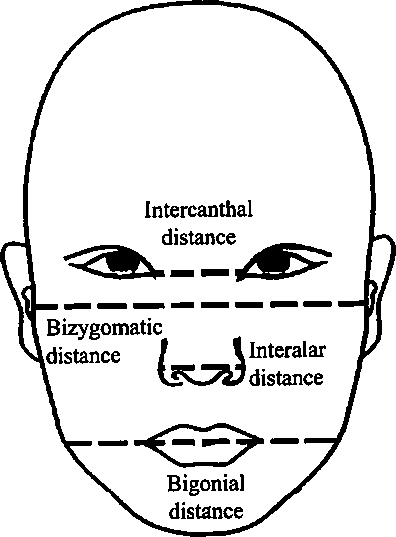Infracture Technique for Reduction Malarplasty with a Short Preauricular Incision
Certain horizontal facial measurements in Asians are significantly greater than those of Westerners. These measurements include the bizygomatic distance, the intercanthal distance, the interalar distance, and the bigonial distance1 (Fig. 1). Aesthetic operations designed to improve balance or proportion in Asian faces typically, directly or indirectly, reduce these horizontal measurements. Dorsal nasal augmentation makes the intercanthal distance appear less, malar base resection decreases the width of the lower nose, and mandibular angle reduction decreases the width of the lower face. In this article, Yang and Chung2 present a modification of their technique of decreasing facial width by malar reduction, using a short preauricular incision. In a large series (142 patients) operated on over a relatively short period (9 months), the authors have modified their external incision. They had previously used an incision starting in the temporal hair-bearing scalp and extending inferiorly to the top of the tragus. They have replaced this incision with one measuring 22 mm placed in the non-hair-bearing skin over the posterior third of the zygomatic arch. It is no longer at the ear cheek interface. Coupled with an intraoral incision, they perform a greenstick osteotomy of the malar body and a complete osteotomy with infracturing and plate-and-screw fixation of the zygomatic arch.
Fig. 1. Horizontal facial measurements, which are characteristically wide in Asians. Adapted with permission from Le, T. T., Farkas, L. G., Ngim, R. C. K., Levom, L. S., and Forrest, C. R. Proportionality in Asian and North American Caucasian faces using neoclassical facial canons as criteria. Aesthetic Plasl. Surg. 26: 64, 2002.
The authors show two clinical cases whereby malar prominence and bizygomatic distance have been effectively decreased by this technique.
The authors have prioritized incision length over incision location. This focus on incision length is also a recent trend in facelift surgery.s.4 is one that contradicts a tenet of plastic surgery.
In Chapter 1 of Fundamental Techniques of Plastic Surgery, Ian McGregor5 emphasizes the importance of incision placement (and not its length) in obtaining an inconspicuous scar. He writes that “when the onus of placing the scar lies with the surgeon, he should place it in or parallel to a wrinkle, in a natural junction line, or where it will not be visible, such as within the hairline.†In this article, the authors have moved their incision from within the temporal hair-bearing scalp to non-hair-bearing skin away from the ear-cheek junction and directly over the site of the zygomatic arch osteotomy.
The two patient examples show excellent improvement in malar contour and overall facial balance but a short preauricular scar in non-hair-bearing cheek skin covered by temporal hair combed over it. This purposeful hair arrangement would also cover the contour step off expected by the relative anterior placement of the zygomatic arch osteotomy. Because the authors have claimed aesthetic superiority by virtue of a shorter scar (which, perhaps, more importantly, is placed directly over the arch osteotomy), it would be informative if the clinical photography would allow evaluation of this scar. Interestingly, in their original presentation 2 of this technique, the long temporal scar is not visible in the clinical examples.
Michael J. Yaremchuk, M.D. Massachusetts General Hospital Boston, Mass. 02114 myaremchuk@partners. org
REFERENCES
1. Le, T. T., Farkas, L. G., Ngim, R. C. K., Levom, L. S., and Forrest, C. R. Proportionality in Asian and North American Caucasian faces using neoclassical facial canons as criteria. Aesthetic Plast. Surg. 26: 64, 2002.
2. Yang, D. B., Park, H. S., and Park, C. G. Technical refinements of infracture for the zygomatic body and arch reduction. Aesthetic Plast. Surg. 22: 380, 1998.
3. Saylan, Z. The S-lift: Less is more. Aesthetic Surg. J. 19: 406, 1999.
4. Baker, D. C. Minimal incision rhytidectomy (short scar face lift) with lateral SMASectomy: Evolution and application. Aesthetic Surg. J. 21: 14, 2001.
5. McGregor, I. A. Fundamental Techniques of Plastic Surgery, 8th Ed. Edinburgh: Churchill Livingstone, 1989. Pp. 4-5.

